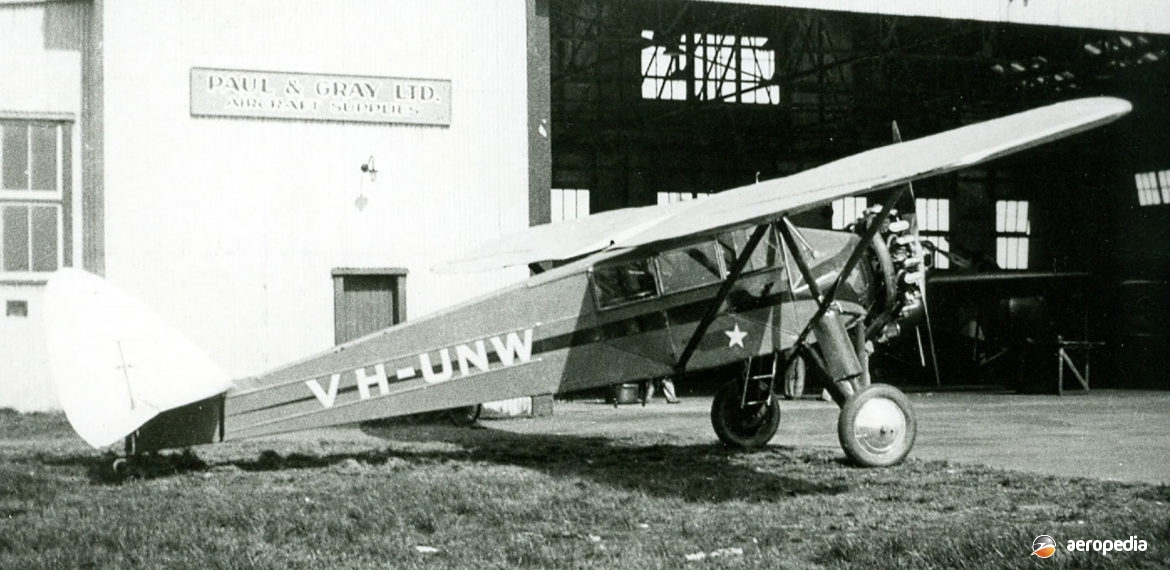Photograph:
de Havilland DH.75 Hawk Moth VH-UNW (c/nn 348) at Mascot, NSW in 1930 (Reddall Collection – AHSA NSW Branch)
Country of origin:
United Kingdom
Description:
Light touring monoplane
Power Plant:
One 149 kw (200 hp) de Havilland Ghost eight-cylinder VEE air-cooled engine
Specifications:
- Wingspan: 14.32 m (47 ft)
- Length: 8.8 m (28 ft 10 in)
- Height: 2.86 m (9 ft 4 in)
- Wing area: 31.02 m² (334 sq ft)
- Max speed: 204 km/h (127 mph)
- Cruising speed: 170 km/h (105 mph)
- Initial rate of climb: 216 m/min (710 ft/min)
- Range: 901 km (560 miles)
- Empty weight: 1080 kg (2,380 lb)
- Loaded weight: 1,656 kg (3,650 lb)
History:
The de Havilland DH.75 Hawk Moth was an attempt by de Havilland to develop an aircraft which provided the comfort one usually associated with a ‘good motor car’. Seating four in two rows, with two doors on the starboard side, it was also aimed at the smaller ‘feeder-line’ market as a commercial airliner. Construction of the fuselage was of steel tubing of square and circular section. The tail surfaces were also steel tube construction, welded, and fabric covered. The wings were of wooden construction, with box spars, and fabric covered.
The engine was the then new de Havilland Ghost, which in effect was two de Havilland Gipsy engines placed together in a VEE formation, using reduction gearing, and providing 149 kw (200 hp). The fuel tanks were placed in the wing, one on each side, and gave direct gravity feed, the capacity being 159 litres (35 Imp gals) in each tank.
The prototype G-EBVV (c/n 327) was flown by de Havilland test pilot Hubert Broad at Stag Lane, Edgeware in Middlesex on 7 December 1928 but it was found to be somewhat underpowered and performance was disappointing. However, production commenced, these aircraft having an increase in wingspan and chord, and being fitted with 179 kw (240 hp) Armstrong Siddeley Lynx engines. These aircraft became known as the DH.75A.
Eight DH.75s were built, and of these, one went in 1929 to the Olympia Aero Show in Europe, and three went to Canada (CF-CCA – c/n 343; G-CYVL – c/n 707; and G-CYVM – c/n 708). Trials with floats were carried out to meet Canadian Government requirements, c/n 343 being used by the Canadian Comptroller of Civil Aviation.
Two examples of the DH.75 were imported to Australia. The first VH-UNW (c/n 348 – ex G-AAFX) was first registered in Australia to de Havilland Aircraft Pty Ltd on 24 April 1930 as a demonstrator. Ownership was changed to Hart Aircraft Service Pty Ltd of Essendon, VIC on 18 April 1931, and Tasmanian Airways Pty Ltd on 15 February 1934, which used it for taxi and charter work. It suffered an engine failure at Brighton, TAS on 15 February 1934. Subsequent owners included Mr G H Purvis, of Earlwood, NSW, at this time the Lynx engine being replaced by a 164 kw (220 hp) Wright Whirlwind J-5C radial engine. In March 1938 it was sold to C O Strong of Geelong, VIC, Messrs J J Smith & J C Morgan in December 1938, and eventually E J Connellan of Connellan Airways, Alice Springs, NT in July 1943.
In May 1945 a 239 kw (320 hp) Armstrong Siddeley Cheetah IX engine was installed in VH-UNW. In his biography, Eddie Connellan, stated that VH-UNW was the first successful aircraft the airline had that was adequately powered. The aircraft was dismantled for a Certificate of Airworthiness inspection by engineer Ivan Hewitt, whomoved to Qantas during the inspection leaving the airframe lying in pieces. Nobody was able to reassemble the sectional tubular airframe and the aircraft was never rebuilt.
It has been said this aircraft was flown by aviatrix Amy Johnson from Brisbane, QLD to Sydney, NW when she visited Australia in the 1930s whilst awaiting repairs to her de Havilland DH.60 Moth ‘Jason’ G-AAAH. The DH.75 was officially withdrawn from use in May 1952.
The second aircraft imported VH-UOY (c/n 706) was first flown at de Havilland’s facility on 5 May 1930 and was powered by a 224 kw (300 hp) Wright Whirlwind J-5 engine. It was registered to de Havilland Aircraft Pty Ltd of Mascot, NSW on 18 September 1930 and operated on the Company’s Toowoomba to Maryborough services in Queensland, in 1931 being used on charter work. Ownership was transferred to Aircrafts Pty Ltd of Brisbane on 18 September 1930. It made a forced landing and was destroyed by fire at Archerfield, QLD on 12 May 1935.

